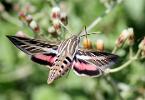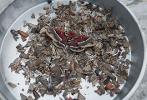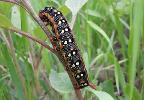Meeting Moths: The Montana Moth Project
Master Gardener Spotlight
Photos (left): Adobe Stock; (middle and right): Anthony Sammartano
Spending time in gardens and open spaces during the day allows us to become observers and appreciators of nature. Pollinators such as bees, butterflies, flies, and beetles can be noted visiting a diverse range of flowers in the daytime, but during the darker evening hours, a barely-thought-about pollinator world emerges.
If there is a chance to spend a warm night outside in the summer, grab a flashlight and peek through a garden or natural area to discover a huge variety of moths. These (mostly) nighttime fliers outnumber butterflies nine to one in species diversity and play a vital role in nature. They serve as herbivores, pollinators and prey in a nighttime world that few see or realize exists. Scientists in Montana are just beginning to study these nocturnal pollinators, and they have formed The Montana Moth Project (MMP) to collect data, raise awareness and increase knowledge about moth species.
The MMP is a statewide survey effort of Northern Rockies Research and Educational Services, an independent biological research nonprofit based in Missoula, and the C.P. Gillette Museum of Arthropod Diversity at Colorado State University. The MMP draws on partnerships with various land management agencies and citizen scientists. From April until the first frost, volunteers and land managers disappear into the dark of night with UV light traps and insect nets, and the excitement of discovery to collect and identify moths.
The goal of the MMP is to increase our understanding of moth species, document distributions and range limits, and begin to piece together habitat associations. This helps scientists clarify the roles certain species play in ecosystems, including agricultural lands.
Montana’s ecological and geographical differences between Western and Eastern regions create niche habitats that numerous species of moths inhabit. This project has led to the description of two new moth species and has identified nearly 3,000 species in Montana. There are likely to be more discoveries in the 2025 field season.
To become a citizen science volunteer, the MMP has a simple and easy way to contribute data to the project using a smartphone. Using the iNaturalist app, submit moth observations to the MMP’s iNaturalist project page (under the ‘Community’ tab, find projects and search for Montana Moth Project). All observations help to increase the catalog of moth species in Montana and give field researchers information on species’ distribution, habitat and host plants, and provide leads to find new species. To participate, please contact Yellowstone County MSU Extension Horticulture Agent Anthony Sammartano ([email protected]) or visit the Montana Moth Project website.
Anthony Sammartano is the MSU Extension Horticulture Agent in Yellowstone County.



